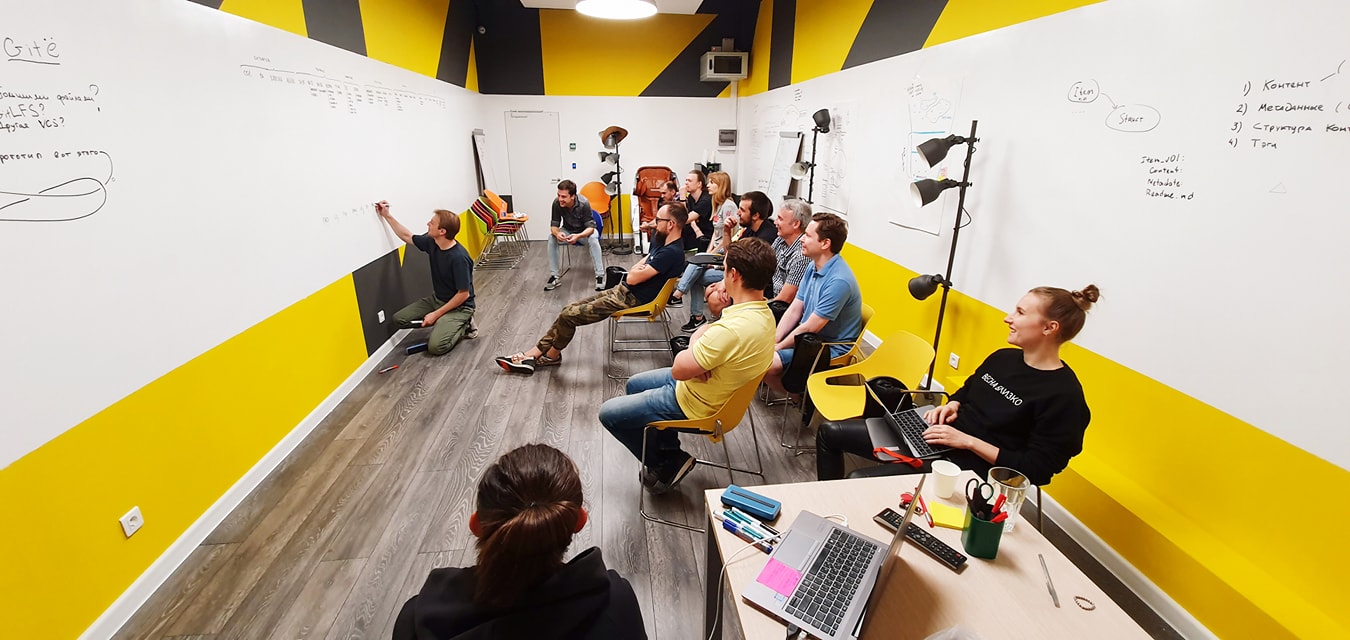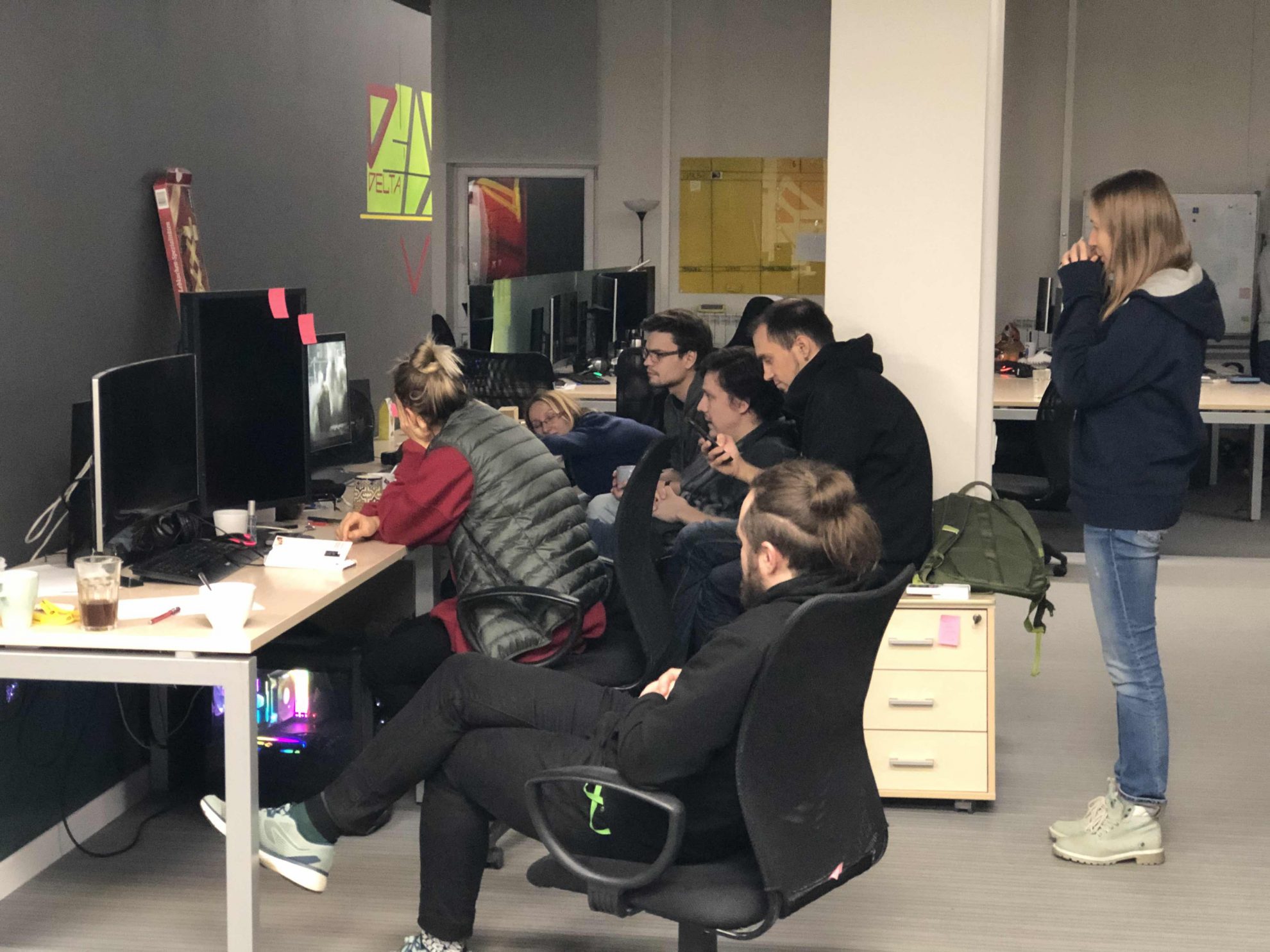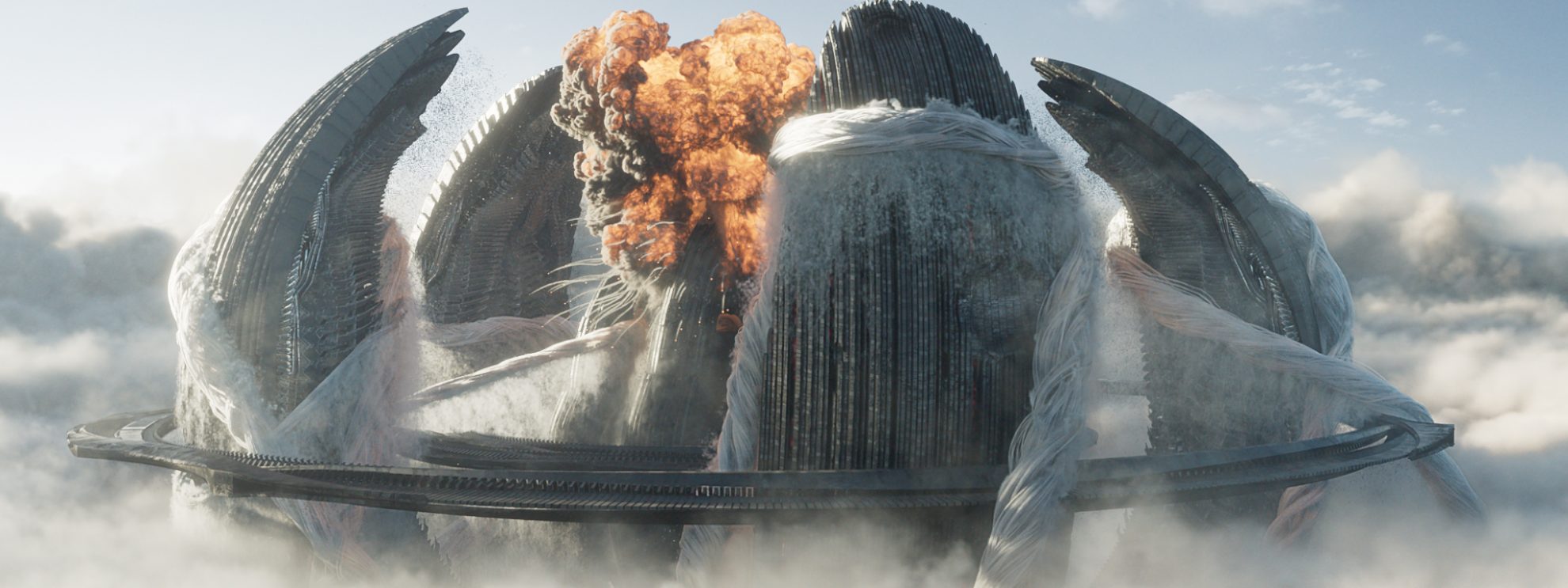Traditionally, in the film business, projects begin in one form and end in another. Nevertheless, the Main Road Post studio managed to finish work on the films Invasion and Attraction on time.
We interviewed the Main Road Post. The team shared their experience working on large and small projects, the introduction of agile and scrum in the production process. We discussed the creation of graphics, labour immigration, the future of the industry, and more.

Please introduce yourselves.
Dmitry Kuznetsov: Dmitry Kuznetsov, a member of the production and supervision team for the Invasion movie.
Anna Moreva: I’m Anna Moreva. I’m a producer and coordinator.
Alexander Lipilin: My name is Alexander Lipilin. I’m a CG artist.
Was there any difference in the production process for Attraction and Invasion?
Dmitry: The difference was quite noticeable when we were making the first movie, Attraction. We had started switching to Scrum and using Agile, and by the time we finished Attraction, this process was more or less complete. Back then we had the first experimental but working version of Scrum, and now we’re making full use of Agile and have switched to team work.
Does Agile help?
Dmitry: Yes, a lot. For Attraction, we had just two supervisors for an enormous amount of work: me and Andrey Maximov. This was a huge problem. The information about the project would pass through us like through a bottleneck, because a lot of shots were outsourced to vendors. The workload was often staggering.
We currently have a supervision and production group, but no supervisors in the classical sense of that word. Our teams usually interact with vendors directly and make their own artistic and technical decisions.
Alexander: If it weren’t for the workflow management system we have now, we most likely wouldn’t have finished Invasion in time.
Dmitry: Yes, I agree.
Speaking of deadlines. How does Agile fit into the film industry? The deadlines are pretty strict, and Agile isn’t really designed for strict timeframes.
Do you ever find yourselves having to fit 30 sprints worth of work into 15 because you need to meet a certain deadline?
Alexander: Firstly, deadlines for both Attraction and Invasion were very strict and couldn’t be changed at all.
Dmitry: For Attraction, it was crucial for us to deliver stereo materials to IMAX, and they really don’t like moving their deadlines. So this wasn’t an option. As for Invasion, we were tied not only to IMAX, but also to the release date of January 1. This is, for obvious reasons, not a release date you can easily move.
Did you have to rely on human resources and overtime to meet these strict deadlines?
Dmitry: Yes and no. Of course we had to do some overtime during the making of Invasion…
Alexander: But this overtime had specific deadlines and volume.
Dmitry: Firstly, yes, and this is very important. Secondly, I’m also part of one of our teams, the Rock Stars. I’m also a VFX artist. We analyzed how we managed to do everything in time and came to the conclusion that it was thanks to the team’s quick decision-making. We worked more or less autonomously and made decisions on the spot, without sending them up and down the corporate ladder. We proposed solutions ourselves, including to the director, and this allowed us to cut many corners and saved us a lot of time.

Alexander: When we were making Attraction, we tried to adhere to strict Scrum rules, whereas now we don’t have sprints in their usual sense. We moved away from Scrum a little in favor of our own modification.
This happens often. Scrum probably doesn’t even exist in its pure form.
Alexander: We tried to create a perfect Scrum framework at first, but after getting a better understanding of it, we started looking at what suited us and what we could change. For Invasion, our teams received feedback clarifying their task at each closed viewing with the director or producer. By the end of the project we would arrange these viewings as often as two or three times a week. So our sprints don’t have a fixed length and last from one viewing to another, but unlike Scrum, each viewing marks not the start of a new sprint, but some adjustments to the work process.
Dmitry: I’d say each team has a slightly different approach to how they organize their work. Some forgo sprints completely, moving closer to Kanban, while others try to maintain the iteration and rhythm of sprints. The studio teams mostly make these decisions themselves.
We recently interviewed Alexey Gusev from ALGOUS studio about his work on T-34. He said that for supervisors and managers a huge project like that always means responsibility, stress, and excitement. It’s always a challenge. They are motivated and inspired by such projects, unlike ordinary employees who want to work at a normal pace and in comfortable conditions. Do you agree with him?
Dmitry: I can’t really agree or disagree. This is how work is done in his studio. The issue of employee motivation lies beyond the scope of Agile and Scrum, because different people are motivated by different things.
Alexander: And everyone has different priorities in life.
Dmitry: There will always be fanatics who actively invest their time and health in a project, sacrifice things for the sake of their passion. They do it knowingly, out of their own free will. And then there are more conservative workers, those who are more careful and more interested in their own professional growth, in money.
I think that the system we have now works best for everyone: the proactive employees who are ready to put their lives into what they do, and those who are more conservative. It allows them to do what they want, without strict separation into departments. So if a person gets tired of one job, they can do something else.

Alexander: One of the reasons we switched to Agile and Scrum was so that everyone could be involved, motivated, and consciously do their jobs to the extent they want and can. If a studio has a strict hierarchy, people on the last leaf of this tree, those who perform some very specific tasks, won’t be able to look at a broader picture.
As a result, they may be not involved enough or have not enough work to do, even if they want to prove themselves. That’s why we don’t have an hierarchy. Artists are part of a team that works at the forefront directly with the director. If people have the desire and motivation to take responsibility, they do it.
Anna: Our employees usually feel this responsibility and are involved in the work process. The fact that feedback comes directly from the director is of utmost importance. When an artist is treated like an actual service provider…
Dmitry: Not just service provider. This is what makes working with Fyodor Sergeyevich so great. He treats everyone as creators. Our relationship is not that of a service provider and a client. We always discuss things. He is a very charismatic man. His energy is inspiring. It’s amazing.
Anna: Everyone can share their opinion and have it heard, and this gives people a creative urge.
Let’s talk more about motivation and self-motivation. Do you feel that your work stays mostly hidden from the mass audience? Few people notice the huge amount of work done by invisible skillful hands. For example, Attraction’s description on Kinopoisk says that some 255 artists from Main Road Post participated in the making of the movie, while the description for Invasion says nothing at all. How do you feel about this? People leave the cinema thinking, “What gorgeous visual effects! Who made them? And why did these people make them with their own hands in Russia?” But no one knows their names.
Alexander: You can watch the credits and see the names. Our work in both films isn’t invisible. I think it’s one of the factors that made the films successful.
Dmitry: We love our job, but we must remember that this is production. We have about 100 employees in our studio, and the credits mentioned about 400 people in total. All of them contributed greatly to the film, but we must understand that people go to the movies to see a story and their favorite actors, not visual effects. Visual effects definitely play an important part, especially in the entertainment genre. But still, who is more important for, say, the Iron Man? Robert Downey Jr. or the people who made the visual effects? In my opinion, Robert Downey played a bigger role in the film’s commercial success.
Sometimes we feel that our efforts don’t get enough recognition, but not when we work with Vodorod and Art Pictures. When we worked with Fyodor and Vodorod’s production group — Alexander Andryushchenko, Mikhail Vrubel — we felt that people appreciated what we were doing.

Let’s talk about pride. Many actors say they don’t watch the films they star in. Do you watch the films for which you create visual effects?
Alexander: But they still attend movie premieres. Do they spend these two hours just looking at their phones? I think the actors who starred in Invasion saw it.
Dmitry: We love our jobs and look at the end result with great pleasure, especially if we talk about films like Attraction and Invasion. They are entertaining, and we certainly feel satisfied with the result. On January 2, I took my parents, brother, my brother’s wife, and my nephew to see Invasion.
Anna: We strive to produce a high quality picture. This is our main goal. If the level of Russian visual effects is growing, it means we’re winning. This may sound pompous, but it’s true. The level keeps growing each year, and that makes us happy.
Alexander: We watch the films we work on and encourage everyone to do the same.
What can you say about the public’s opinion of Russian movies? Do you ever hear people say, “Invasion looks great, but the plot is average.” Is there such a bias among your friends and relatives?
Dmitry: Yes. Moreover, some of my friends had a negative opinion of Invasion from the start and didn’t go to see it for their own reasons. This topic can be discussed over and over. We’ll still keep doing what we do and will be proud of our work, because that’s the only way we can change something.
Alexander: People have the right to hate something, let them use it. These people probably also don’t like Russian cars and football.
Dmitry: There are reasons for such strong negative feelings. After the Soviet film school died, late 80s and 90s became a difficult turning point: the past was in the past, and something new was emerging.
I think people keep scoffing at Russian films out of habit, even though there are many great ones these days. Russian movies demonstrate great box office results. This means that the quality is improving. People vote with their money. There will always be negative YouTube comments, of course, but it doesn’t matter.

Alexander: I think many of the loudest voices we hear on the Internet belong to people who just genuinely can’t watch Russian movies the way they are made today. They want to watch something no one has filmed yet. And that’s a great opportunity.
Take Bad Comedian and his audience. He could make a movie that they’d love. We make mainstream movies for the widest possible audience, but you could shoot films that are much more niche, and demand for them will only increase.
At the same time, I’d lie if I said that haters don’t bother us at all. Of course they do. We always read online comments. But over time, you develop a kind of immunity. When we were just starting out, we’d get into fights on the Internet, but now we’ve gotten used to it and can read different opinions without taking them to heart.
Let’s get back to Invasion. What do you mean when you say you worked directly with the director? Do you have a hierarchy? And who has the final say when it comes to making decisions?
Dmitry: There used to always be an intermediary between the director and the ones who bring the director’s ideas to life: a supervisor (or supervisors) and leads who transform what the director says. This distorts information. A supervisor not always understands what’s important to the director. They could make a VFX artist do a lot of unnecessary work. This is how we work now: the director comes to our viewing room and watches the material together with all the teams. Together with Alexander Andryushchenko, producer and film editor, he comments on what he sees, and the teams can ask the director for clarifications regarding his comments. This way there is no supervisor as an intermediary.
Alexander: It should be added that this work begins even earlier. First, the team representative says, “Hi, we did this and plan to do that, and here we need some feedback.” So the director and the producer don’t just give abstract feedback. They may not see the artist in the dark viewing room, but they talk to them, and this direct communication feels very human and personal. This allows us to come to an understanding much faster.
Did you devise this approach yourselves?
Dmitry: Arman Yahin did. He was very keen on introducing this system, even despite some resistance from within.
People didn’t understand what the system was about, so Arman spent months telling everyone why it was important and necessary. Not everyone could work like that, a few people left, but now we feel that everything is good.
For producers and directors this is also something new. And here we should also thank Arman and Julia Huene: they explain to producers and the director why this approach works better. In the end, directors like this way of interacting with the team, despite the fact that this is unusual for them.
And how do people from outsourcing, vendors from Hungary, Poland, Kazakhstan, and Ukraine fit into your “work directly with the director” approach?
Dmitry: Unfortunately, it’s impossible to connect vendors directly to the director. The closer and more direct the contact, the better, so we try to pass on information as accurately as possible. Each vendor has to pass our quality check first, to make sure the quality of their work matches ours and the end result looks the same. We try to convey the words of the director and producers to our vendors without changing them.
So you send the work of vendors to the director and producers, and then send back feedback? Does everything go through you?
Dmitry: Yes. But there are really good vendors whose work doesn’t need any adjustments. We send it to the director and producers directly. There is no ping ponging.

You interact with a huge number of people. How do you manage to do your work and outsource different tasks without going crazy?
Alexander: Thanks to Cerebro (laughs).
Dmitry: It’s because our production and supervision group is decentralized. It includes me, Andrei Maximov, Sergey Shuppo, Alexander Lipilin, Anna Moreva, Victoria Balyan, Dilya Rakhmanova, Bema Nuradinova, Anna Buleiko, Anastasia Ivanova, and Julia Huene. There is no bottleneck. The production and supervision group also works as a team, and not as a single person.
Alexander: As our employees in the studio mostly work in teams, our supervisors and producers mainly interact with vendors.
Let’s talk a little about the technical side of things. Does the production process differ when you’re making films and graphics for IMAX and non-IMAX formats? Are there two parallel processes or just one?
Dmitry: IMAX has a very strict film delivery schedule so that they can convert the files in time. Other than that, all formats and color models stay the same, and only the stereo process differs.
You work on large projects that are on everyone’s lips. Tell me, when you come to work, do you think “I’m working on Invasion. It’s so cool, it’s such a big project. I’m proud of myself,” or is it more like, “It’s a big project with a fixed deadline. Oh my god, it’s a huge responsibility”?
Dmitry: Whether the project is large or small, I always feel excited. I always want to do things better than I did before, regardless of the size of the project. Each new project needs to be a step up from the previous one.
Anna: The same goes for the production and coordination department. Each project is an experience, and we try to change some things and use something new to make our work easier next time. A big project is a great experience. But small projects can also be so complex that they’ll give you even more experience. I agree with Dima. We give the same effort no matter the size of the project, big or small. We never think that “it’ll do.” We always try to get the best result we can.
Alexander: We’re also lucky. We get to work on projects we like and find interesting.
Do you ever fear that you won’t be able to do everything as good as last time?
Dmitry: As for me, I always have this fear of not finishing things in time. Like when we were working on Invasion. At some point I simply didn’t know if we would make everything in time. When I look back, I realize that fear helps me generate new solutions. You see that the old approach no longer works, so you have to come up with something new all the time.
Anna: Yes, it forces you to act. There is no time to relax. But if you’re not afraid, you may be overly self-confident. You never know what you can do till you try.
How did you get this good at visual effects? Where did you learn all this?
Dmitry: It’s different for everyone. But we all want to keep improving, to do better with each new project, to reach a new level. We never allow ourselves to slack off, we always give as much as we can. For example, we were making this very large shot for Invasion. It was almost the end of the project, so we were trying to finish it and add it to some DCP version.
Alexander: The producers were pleading us to let them go. But we insisted on polishing it some more.
Dmitry: Talking about overtime. It took us two days to finish that shot.
Alexander: We have a very funny picture of half the studio gathered around a single workplace, with everyone trying to do something.
Dmitry: It’s great that everyone wants to work in that rhythm. Nobody forces anyone, this is the initiative of all employees. It always gives me a feeling of victory and makes me feel proud of my work.

Anna: And since everyone always tries to do their best, it’s customary in our studio to readily help each other. Those who don’t have sufficient knowledge ask for advice, and those who have that knowledge share it. This mutual aid also helps us achieve such good results.
Some people say that Main Road Post has an excessive quality of visual and special effects, that they are very detailed. What does excessive mean? Is there a point after which it’s better not to add more visual effects?
Alexander: I doubt there is such thing as excessive visual effects quality.
Dmitry: Artists can really be perfectionists sometimes and pay attention to things that aren’t important for the shot and that no one will ever see. They can spend several weeks working on them. We try to minimize this. Agile and Scrum help quite a lot in making us do only what is important for the shot.
This is difficult, because most of our employees are very creative and really love what they do, so they often do more than necessary. In recent years, we’ve been trying to do only what is important for the shot, only what is visible. For example, not working on the whole model if only one side is visible…
Alexander: If you can only see one side of a model, it might not have the other side. So all the details from that other side moved here and it looks like there are a lot of them, but this is an illusion.
Dmitry: If you noticed these details, it means they were in the right place and created a beautiful and rich image.
Alexander: As we quickly assemble draft shots and see what they are composed of, we can focus all our efforts on important things and not work on something the viewer won’t see. If you break a shot down, it often turns out that it’s made of fairly simple elements that, when put together, create a good and correct result.
Many people move abroad after working on large projects here. Do you ever think that with your skills, you could work abroad and get your well-deserved billions instead of making Russian movies?
Dmitry: People move to new places, and that’s great. This is their choice. If a person feels happier elsewhere thanks to what they learned here, it’s wonderful. When I applied for this job, I honestly warned Arman that I intended to work here for several years, put together a portfolio, and leave to work abroad. Arman shrugged and said, “Okay, but you might change your mind later.” I chuckled back then, but now I realize that I don’t want to leave. This place is more interesting. I already know a lot about what’s it like out there. And I don’t want it to be this way here, at Main Road Post. Some people probably do, and there is nothing wrong with that. This is natural for them.

Do you think the moment will come when Russian audience will start appreciating Russian movies and visual effects, acknowledge your work, and stop laughing at our film industry?
Dmitry: This is a deeply philosophical question.
Anna: Yes, this is a philosophical question. It’s not just about the quality of the picture they see, but also the Russian mentality as a whole. If we’re talking about visual effects, this might happen pretty soon. But a movie isn’t just one thing. The visual effects, the script, the acting, the unbiased attitude of the audience. They are all part of a whole. But I think this moment is growing closer.
Dmitry: If you compare the movies we make today with those that were produced some twenty years ago, you’ll see that they’ve changed a lot and continue to develop. But there will always be people who are dissatisfied with something.
Anna: This is also normal.
Dmitry: Looking at the grosses of Ice 2 and Serf, we can already see that people want to watch Russian films. This means that, in general, people like them.
Anna: This means that things are getting better and people’s attitude is also changing. They are ready to watch these films with an open heart and enjoy them.


